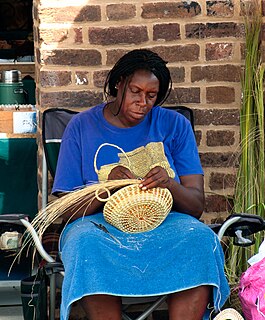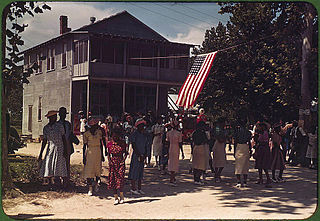
Simbi is a large and diverse family of serpents also known as loa in Haitian Vodou. Some names for the Simbi loa include Simbi Dlo, Simbi Makaya, Simbi Andezo, and Gran Simba. Traditionally in their Kongo context, they are all associated with water, but in the Haitian Vodoun context they have wide-ranging associations. For example, Simbi Makaya is a great sorcerer and served in particular in the Sanpwel secret societies. Simbi Anpaka is a loa of plants, leaves, and poisons.

Gullah is a creole language spoken by the Gullah people, an African-American population living in coastal regions of South Carolina and Georgia as well as extreme northeastern Florida and the extreme southeast of North Carolina.

Hoodoo is a set of spiritual practices, traditions, and beliefs created by enslaved Africans in North America that were held in secret from slaveholders. Hoodoo evolved from various traditional African religions and practices, and in the American South, incorporated various elements of indigenous botanical knowledge. In the Gullah South Carolina Lowcountry, Hoodoo is also known as "Lowcountry Voodoo." Following the Great Migration of African-Americans, Hoodoo spread throughout the United States. Practitioners of Hoodoo are called rootworkers, conjure doctors, conjure man or conjure woman, and Hoodoo doctors. Regional synonyms for hoodoo include conjure or rootwork.

The Gullah are African Americans who live in the Lowcountry region of the U.S. states of Georgia, Florida, South Carolina, and North Carolina, in both the coastal plain and the Sea Islands. They developed a creole language, also called Gullah, and a culture with some African influence.

St. Helena Island is a Sea Island in Beaufort County, South Carolina, United States. The island is connected to Beaufort by U.S. Highway 21. The island has a land area of about 64 sq mi (170 km2) and a population of 8,763 as of the 2010 census. It is included as part of the Hilton Head Island-Beaufort Micropolitan Area. The island is renowned for its rural Lowcountry character and being a major center of African-American Gullah culture and language. It is considered to be the geographic influence behind the children's television program Gullah Gullah Island.

Marquetta L. Goodwine is an author, preservationist, and performance artist who serves as Queen Quet, Chieftess of the Gullah/Geechee Nation.
Emory Campbell is a community leader among the Gullah people, African Americans who live in the coastal low country region of South Carolina and Georgia. The Gullahs have preserved more of their African linguistic and cultural heritage than any other black community in the US.
Vertamae Smart-Grosvenor was an American culinary anthropologist, griot, food writer, and broadcaster on public media. Born into a Gullah family in the Low Country of South Carolina, she moved with them as a child to Philadelphia during the Great Migration. Later she lived in Paris before settling in New York City. She was active in the Black Arts Movement and performed on Broadway.

McLeod Plantation is a former slave plantation located on James Island, South Carolina, near the intersection of Folly and Maybank roads at Wappoo Creek, which flows into the Ashley River. The plantation is considered an important Gullah heritage site, preserved in recognition of its cultural and historical significance to African-American and European-American cultures.

Joseph A. Opala, OR is an American historian noted for establishing the "Gullah Connection," the historical links between the indigenous people of the West African nation of Sierra Leone and the Gullah people of the Low Country region of South Carolina and Georgia in the United States.
Angolan Americans are an ethnic group of Americans of Angolan descent or Angolan immigrants. According to estimates, by the year 2000 there were 1,642 people descended from Angolan immigrants in the United States. However, the number of Angolan Americans is difficult to determine. Many African-Americans are descendants of Angolan slaves. In 1644, most of the 6,900 slaves bought on the African coast to clear the forests, lay roads, build houses and public buildings, and grow food came from the established stations in Angola.

Sierra Leonean Americans are an ethnic group of Americans who are descended from Sierra Leoneans. The population of Sierra Leonean Americans is relatively large and consists, according to surveys of 2013, of 21,538 people. are descended also from Sierra Leonean slaves who were exported to the United States since the 18th until the early 19th century, so the number of people with that heritage should be much higher. So, the number of slaves from present Sierra Leone exported to present United States exceeded the 25.000 people. A particular group of people of partially Sierra Leonean descent in United States is that of the Gullah, who, descendants of slaves, fled their owners at the end of the 18th and early 19th century and they established in parts of South Carolina, Georgia, and the Sea Islands, areas in which, even today, they retain their cultures. Moreover, according to the American Community Survey, there are 34,161 Sierra Leonean immigrants living in United States.

The Gullah-Geechee Cultural Heritage Corridor is a federal National Heritage Area in the United States, representing the significant story of the Gullah-Geechee people for maintaining their cultural traditions, and for being a reflection of the values of ingenuity, pride, and perseverance. The intent of the designation is to help us to preserve and interpret the traditional cultural practices, sites, and resources associated with Gullah-Geechee people. Gullah-Geechee Cultural Heritage Corridor, and the federal Gullah-Geechee Cultural Heritage Corridor Commission established to oversee it, were designated by an act of Congress on October 12, 2006 through the National Heritage Areas Act of 2006.

Sassafrass, Cypress & Indigo is a 1982 novel written by Ntozake Shange and first published by St. Martin's Press. The novel, which took eight years to complete, is a story of three Black sisters, whose names give the book its title, and their mother. The family is based in Charleston, South Carolina, and their trade is to spin, weave, and dye cloth; unsurprisingly, this tactile creativity informs the lives of the main characters as well as the style of the writing. Sassafrass, Cypress & Indigo integrates the whole of an earlier work by Shange called simply Sassafrass, published in 1977 by Shameless Hussy Press. As is common in Shange's work, the narrative is peppered with interludes that come in the form of letters, recipes, dream stories and journal entries, which provide a more intimate approach to each woman's journey toward self-realization and fulfillment. The book deals with several major themes, including Gullah/Geechee culture, women in the arts, the Black Arts Movement, and spirituality, among many others.

Hog Hammock is an African-American community on Sapelo Island, a barrier island of the U.S. state of Georgia.
Geechie is a word referring to the U.S. Lowcountry ethnocultural group of the descendants of West African slaves who retained their cultural and linguistic history, otherwise known as the Gullah people and Gullah language. It has been used as a nickname for persons originating out of this culture and ethnic group. The term derives from the name of the Ogeechee River, an area where many of them settled.
The Geechee or Gullah are African Americans who live in the Lowcountry region of the U.S. states of Georgia, Florida, and South Carolina.
Edda L. Fields-Black is an African-American historian who is currently Associate Professor of History at Carnegie Mellon University. She is known for her research on West African rice agriculture and societies and the African diaspora.
Griffin Lotson is an African-American historian, born in Crescent, Georgia. He is a seventh-generation Gullah Geechee. He serves as a councilman and the mayor pro-tem in Darien, Georgia. He also manages the Geechee Gullah Ring Shouters. He is the national Federal Government vice-chairman and former treasurer of the federal Gullah Geechee Cultural Heritage Corridor Commission.











